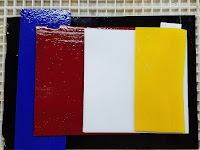 |
| Glass for my Mondrian plate |
Not surprisingly - you can't fuse just any old glass - and even when it is made for firing and fusing, it's not all compatible. Even glass from the same company isn't always a match - so it's important to understand some of the science behind the glass.
All fusible glass has a coefficient of expansion (COE) - which refers to the rate the glass expands (and contracts) when it is heated (or cooled). The two most common types of glass are COE 90 and COE 96. You can't mix them - so you work with one or the other. We have been working with COE 90. I have some COE 96 shards that the Salado Glassworks folks gave me - but I'm saving them for another time.
In order for glass to be successfully fused (in a kiln) there is a very specific schedule for heating and cooling the pieces so that they will bond without breaking. Heating or cooling too quickly can stress the glass, and ruin all the hard work that went into creating a piece...and the bigger the finished piece, the more careful you have to be with the timing.
 |
| Photo credit: Bullseye |
 |
| Photo credit: Bullseye |
Pink and purple glass get much of their color from lead, and reds, yellows, oranges and some greens contain sulfur or selenium.
So, it's really important to check to see if the sheets of glass you are using are reactive - because if they are, and you aren't careful - you are likely to end up with something very different that what you planned.
For some glass, heat has no impact on the color - what you see when you pull it off the shelf is what you will get when it comes out of the kiln. Other pieces - called strikers - will change color, and the hue and depth of the change will vary based on how much heat is applied.
Some of my classmates are very spontaneous - mixing and matching, experimenting and taking their chances - which is great, but it's not me. I've been spending a fair amount of time before each class looking at the Bullseye catalog and making a plan for each piece. This should not come as surprise to anyone who knows me - or has been reading the blog for a while. I am a planner to my core.
 One of the first things I'm planning with respect to my jewelry is fused glass bars for earrings. Here's a sneak peek at my first experimental pair (pre-fusing).
One of the first things I'm planning with respect to my jewelry is fused glass bars for earrings. Here's a sneak peek at my first experimental pair (pre-fusing).Until next time.
No comments:
Post a Comment